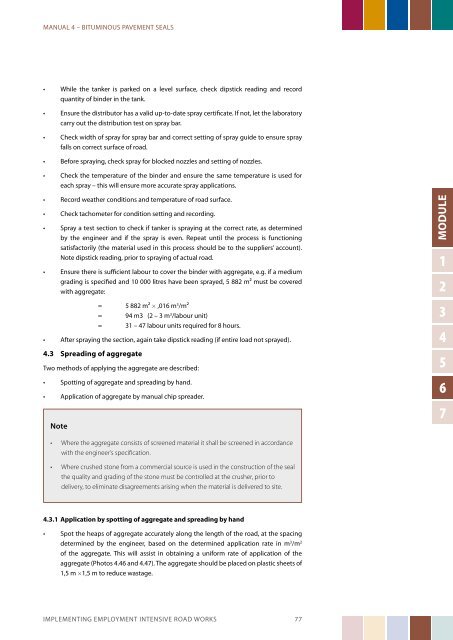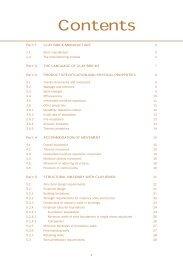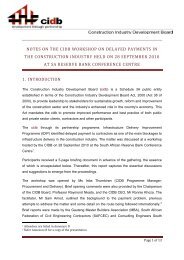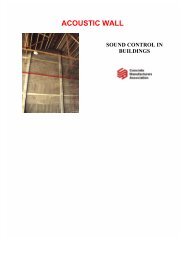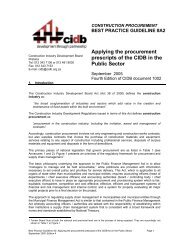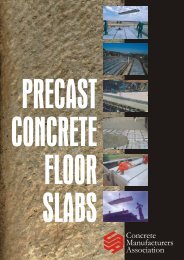MANUAL 4 - Construction Industry Development Board
MANUAL 4 - Construction Industry Development Board
MANUAL 4 - Construction Industry Development Board
Create successful ePaper yourself
Turn your PDF publications into a flip-book with our unique Google optimized e-Paper software.
<strong>MANUAL</strong> 4 – BITUMINOUS PAVEMENT SEALS<br />
• While the tanker is parked on a level surface, check dipstick reading and record<br />
quantity of binder in the tank.<br />
• Ensure the distributor has a valid up-to-date spray certificate. If not, let the laboratory<br />
carry out the distribution test on spray bar.<br />
• Check width of spray for spray bar and correct setting of spray guide to ensure spray<br />
falls on correct surface of road.<br />
• Before spraying, check spray for blocked nozzles and setting of nozzles.<br />
• Check the temperature of the binder and ensure the same temperature is used for<br />
each spray – this will ensure more accurate spray applications.<br />
• Record weather conditions and temperature of road surface.<br />
• Check tachometer for condition setting and recording.<br />
• Spray a test section to check if tanker is spraying at the correct rate, as determined<br />
by the engineer and if the spray is even. Repeat until the process is functioning<br />
satisfactorily (the material used in this process should be to the suppliers’ account).<br />
Note dipstick reading, prior to spraying of actual road.<br />
• Ensure there is sufficient labour to cover the binder with aggregate, e.g. if a medium<br />
grading is specified and 10 000 litres have been sprayed, 5 882 m² must be covered<br />
with aggregate:<br />
= 5 882 m² 3 ,016 m 3 /m²<br />
= 94 m3 (2 – 3 m 3 /labour unit)<br />
= 31 – 47 labour units required for 8 hours.<br />
• After spraying the section, again take dipstick reading (if entire load not sprayed).<br />
4.3 Spreading of aggregate<br />
Two methods of applying the aggregate are described:<br />
• Spotting of aggregate and spreading by hand.<br />
• Application of aggregate by manual chip spreader.<br />
Note<br />
• Where the aggregate consists of screened material it shall be screened in accordance<br />
with the engineer’s specification.<br />
• Where crushed stone from a commercial source is used in the construction of the seal<br />
the quality and grading of the stone must be controlled at the crusher, prior to<br />
delivery, to eliminate disagreements arising when the material is delivered to site.<br />
4.3.1 Application by spotting of aggregate and spreading by hand<br />
• Spot the heaps of aggregate accurately along the length of the road, at the spacing<br />
determined by the engineer, based on the determined application rate in m3 /m2 of the aggregate. This will assist in obtaining a uniform rate of application of the<br />
aggregate (Photos 4.46 and 4.47). The aggregate should be placed on plastic sheets of<br />
1,5 m 31,5 m to reduce wastage.<br />
IMPLEMENTING EMPLOYMENT INTENSIVE ROAD WORKS 77<br />
MODULE<br />
1<br />
2<br />
3<br />
4<br />
5<br />
6<br />
7


